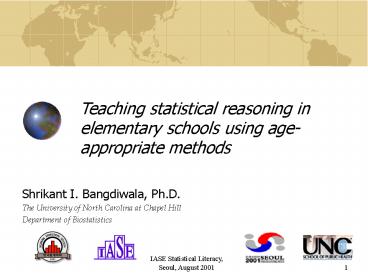Teaching statistical reasoning in elementary schools using age-appropriate methods PowerPoint PPT Presentation
Title: Teaching statistical reasoning in elementary schools using age-appropriate methods
1
Teaching statistical reasoning in elementary
schools using age-appropriate methods
- Shrikant I. Bangdiwala, Ph.D.
- The University of North Carolina at Chapel Hill
- Department of Biostatistics
2
Issue
- In the USA, children in elementary school are
taught arithmetic and mathematics, but not
statistics - Teaching the concepts and principles of
statistics is fundamental for developing an
understanding of - Uncertainty
- Variability
- Probability
- Risk
3
Rationale
- Statistical concepts can be effectively imparted
to elementary school children if done in an
age-appropriate manner
4
Methods
- In the USA, parents are allowed to actively
participate in the instruction in public schools - I personally volunteered to teach math classes
for my two children ? teachers were more than
happy to have a guest instructor teach a class
5
Second grade ages 7 8
- Children love games and have learned to count ?
- Teach goodness-of-fit, composition bar graphs
- Using an ancient game from India with oblong dice
chaupar or soktabaji - Concepts fairness probability and expected
outcomes ? variability, uncertainty
6
Chaupar / soktabaji
Played by the Emperor Akbar I of the 16th century
Mogul Empire Lead to the Western games of Ludo
and Pachisi
7
Chaupar
- Rules
- Each of four players moves his/her pieces
(soktas) around the path of squares while
avoiding being caught and forced to re-start - Advance is based on roll of 5 cowry shells or two
oblong dice - Objective is to be the first to get all ones
pieces safely home
8
Chaupar
- Dice
- Oblong dice had numbers 1, 3, 4, and 6
- Dice of ivory unavailable today except as antiques
Possible outcomes 2 3 4 5 6 7 8 9 10 11 12
Probability Distribution x16 1 0 2 2 1 4 1 2 2 0 1
9
Strategy
- I made several dice out of hard acrylic, cut to
the correct size and labeled discussed how do
we know which dice are fair? - Children were enlisted to pick a die during math
center and in teams, roll it 100 times - They counted off squares in a data form
visually constructing a bar chart - I produced summary charts after all dice were
thrown 1000 times (several weeks) and the class
determined the dice that were fair
10
Fourth grade ages 9 10
- Children love candy and have learned fractions ?
- Teach sampling distribution of the mean,
estimating proportions - Using colored MM plain candy bags
- Concepts variability, sample size, estimating
probabilities
11
M M candy
- Candy sold in packages of various sizes
- Marketing campaigns by the MM Mars Company have
focused on the distribution of colors
12
Strategy
- Focused on the fraction of candies in a bag
that were RED - Children got a partner and were placed in tables
of 4 - Each child received a small package of candy
- Children made bar charts with their data and
calculated their fraction special forms - Estimates charted on the blackboard
- Each team of two calculated a pooled-data
fraction charted on same blackboard just below
previous chart - Each table calculated a pooled-data fraction
charted on same blackboard just below previous
charts
13
Discussions
- Variability in the number of MMs per same size
bag very important to the children! - Do not tamper with your data until the end of
the study Do not eat your data ! - Variability of the estimated proportions
- Central tendency of the estimated proportions
- How larger sample sizes (double and quadruple)
got less variability of the estimated
proportions, but same central tendency - Bell-shaped distribution of the sample of
estimated proportions is better for larger sample
sizes
14
Sixth grade ages 11 12
- Children fascinated by probability ?
- Teach sampling techniques
- Using sampling demonstrator of 10,000 colored
balls of various colors, sampling palettes - Concepts sampling variability, precision of
larger samples
15
Strategy
- Basically similar to the MM exercise, but
children are older and do not need candy bribe - Concept of sampling from a population to give
equal chance of selection and not introduce
selection biases - mixing of balls
- palettes with holes for objectivity
- Sampling palettes of sizes 10, 25, 50 and 100
illustrate the reduced variability and increased
accuracy in samples of larger sizes
16
- And for the future
17
Eight grade ages 13 14
- Childrens bodies are changing and they are able
to cook ? - Teach experimental design in biology class or
chemistry class - Having them conduct small experiments
- growing small plants under different conditions,
or - Cooking under different variations of ingredients
- Concepts uncertainty in outcome, likelihood and
relative risk
18
Tenth grade ages 15 16
- Children noticing their bodies ?
- Teach measurement error and summary measures
- Having them create their own data by measuring
their heights, weights, skinfolds, and other
anthropometric values - Concepts variability, representativeness of the
classroom
19
Twelfth grade ages 17 18
- Children more interested in the World ?
- Teach utility of statistics in daily life
- Use examples from politics, media, Census,
medical research - Concepts utility of statistics in everyday life,
relative risk of their behaviors
20
Conclusions
- Keep statistical literacy approaches to
age-appropriate techniques - Make it fun !!!

